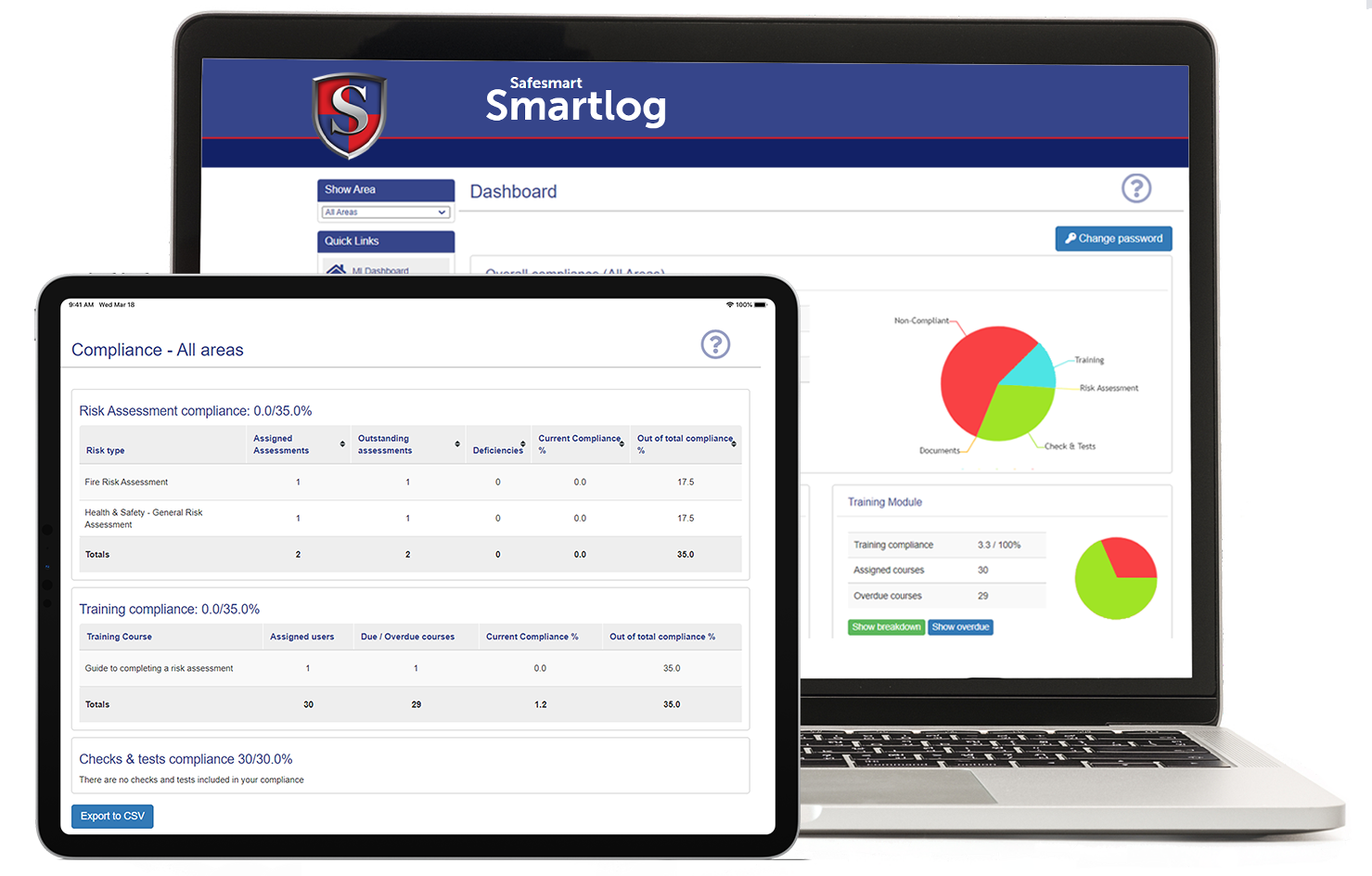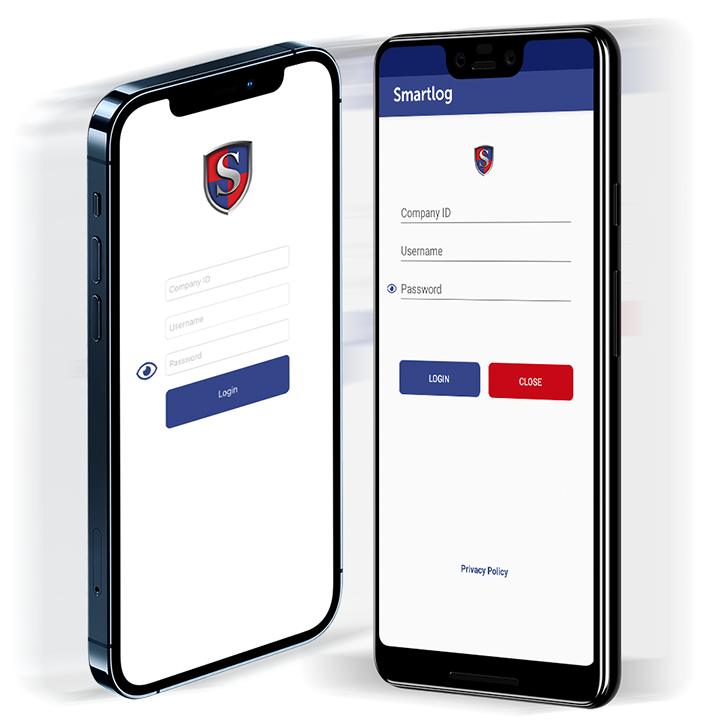Main Modules
Risk Assessment
E-Learning
Checks & Tests
Accident Reporting
Asset Management
Help Desk
in your organisation, which can be tracked, updated & then resolved.
Document Library
Contract Management
Medical Tracking
Health and Safety Software
There are hundreds of thousands of workplace safety failings across the United Kingdom every year, with many of them resulting in serious injuries and fatalities. In order to reduce dangers and make the workplace a safer environment, legislation concerning health and safety is very strict.
Breaching these laws carries the threat of a heavy fine, prosecution — or both.
Smartlog® is health and safety software to assist employers in effectively managing and enforcing all compliance requirements for their organisation.
Other Features

Instant overview
Personalise your compliance
In-depth reporting
Smartlog® App
Offline Access
Multimedia Support
NFC & Barcode Scanner Support

Additional Benefits
Bespoke Development
Customer Service
Frequently Asked Questions (FAQs)
Health and safety software – also known as OHS (Occupational Health & Safety) software, is an online portal or platform designed to assist employers in their management of health and safety compliance in the workplace.
Health and safety software systems vary in the amount of management assistance that they provide, ranging from some being a simple logbook platform to others functioning as a real-time safety monitoring system, integrated with other business management software.
For health and safety personnel, OHS software replaces a number of manual processes and also provides a digital assistant, training platform and communications network. However, for smaller businesses that normally cannot afford to employ full-time health and safety personnel, OHS software allows any competent person to look after the organisation’s health and safety.
Your health and safety software needs are largely dependent on your work environment, as well as the types of activities which frequently take place within your workplace. Good health and safety software should address your specific areas of concern, improve your workflow, and provide transparency.
In an office setting for example, training is important but your safety system should still prioritise risk assessment because there are still many safety hazards present, even though they might not appear obvious. In a more physical work environment, your health & safety software system will require additional functions for tracking and reporting hazards in real-time, because the risks are much higher and impactful.
No. Smartlog is cloud-based software, which means it can be fully accessed from any web browser and on any device with access to the internet.
All you need is your login details – there is no need to install or download anything.
From onboarding, a health and safety software system will save countless admin hours by immediately replacing traditionally written and filed processes. Whilst every paper-based work system involves individual stages of completion such as drafting, communicating and filing, a digital system already has these stages integrated.
More commonly, some organisations use multiple software systems for different processes – from standalone risk assessment software and accident reporting systems to HR software for managing personnel. This creates a complicated network of multiple systems with a large margin for blindspots, general miscommunication and, predictably, reduced safety.
Smartlog integrates different compliance processes within a single system, providing the accessibility and security that using multiple software platforms or a paper-based system simply cannot provide.
A health and safety management system plays a crucial role in ensuring workplace safety and well-being. Here are some reasons why it is important:
Risk Reduction: An effective Health and Safety management system helps minimize workplace hazards, reducing the risks of accidents and injuries. By identifying potential dangers and implementing preventive measures, organisations create a safer environment for their employees and visitors.
Legal Compliance: While not legally mandatory, having a health and safety management system provides a structured framework for meeting health and safety requirements. It ensures that organisations adhere to relevant laws and regulations, avoiding penalties and legal issues.
Employee Morale: A safe workplace fosters employee morale and motivation. When workers feel secure, they are more engaged, productive, and satisfied. A health and safety management system promotes a culture of care and responsibility.
Improved Reputation: Demonstrating commitment to safety enhances an organisation’s reputation. Clients, customers, and other stakeholders often appreciate businesses that prioritise the well-being of their workforce. Therefore a positive safety record can attract more business opportunities.
Continuous Improvement: A Health and Safety management system encourages regular assessments, audits, and reviews. Businesses can learn from incidents, adapt their safety practices, and continuously improve their processes. A successful health and safety management isn’t just about having a system, but it’s about cultivating a safety-conscious culture within the organisation.
As a formal way of managing workplace hazards, a health and safety management system reduces accidents and injuries, as well as promoting a safe and healthy work environment, some of the main benefits of a health and safety management system are:
• It is morally right to ensure your workers return home safe and healthy at the end of every working day.
• It improves health and safety performance and compliance with legal requirements.
• It reduces the cost associated with accidents and incidents, such as medical expenses, compensation claims, and fines.
• It improves staff relations and morale, as workers feel more valued and respected by their employers.
• It improves business efficiency and productivity, as workers are more motivated, engaged, and less absent due to illness or injury.
• It improves public image and reputation, as customers, investors, and other stakeholders prefer to deal with ethical and responsible businesses that protect their workers and the environment.
• It lowers insurance premiums and facilitates access to finance, as insurers and lenders recognise the lower risk profile of businesses with a health and safety management system.


